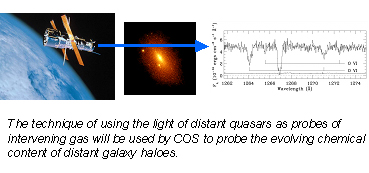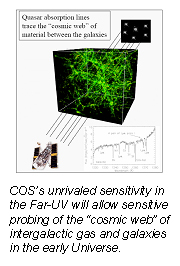Overview 
Instrument Details
Science Details
Overview
The Cosmic Origins Spectrograph, or COS, will study how galaxies,
stars and planets formed and evolved, and will help determine how elements needed for
life such as carbon and iron first formed.
COS, the most sensitive ultraviolet spectrograph ever built for space, will be mounted on the
Hubble Space Telescope, accompanying four other main instruments. This is not the kind of instrument
most people associate with Hubble, yet it will broaden Hubble's capabilities tremendously.
As a
spectrograph, COS won't capture the kinds of images that made Hubble famous. Rather it will perform
spectroscopy, the science of breaking up light into its individual components, just like raindrops
break up sunlight into the colors of the rainbow. COS will create graphs of jagged lines that reveal
information about the temperature, density, velocity and chemical composition of the objects it
observes. A spectral signature of hot ultraviolet-emitting gas can be as unique as a fingerprint,
allowing scientists to "sample" that gas so far away. So just like a Hubble picture, a spectrograph
is worth a thousand words, if not more.

COS observes that part of the electromagnetic spectrum that is "over the rainbow," beyond the
visible light our eyes can detect. The ultraviolet light that COS will detect is, in fact, the type of radiation
that causes sunburn.
+ Back to Top
Instrument Details
The COS science team, led by Dr. James Green of the University of Colorado, conceived an exquisitely optimized
instrument. Foregoing design complexities, they concentrated on performance capabilities that would enable precise
observations of the spectra of very faint objects across the universe and far back in cosmic time. The COS and the
Space Telescope Imaging Spectrograph (STIS), currently onboard Hubble, are highly complementary in their capabilities.
The STIS, which was installed in 1997 during Servicing Mission 2, suffered an electronics failure in 2004 and is no
longer working. STIS might be repaired during Servicing Mission 4. The two spectrographs working together would provide
a full set of spectroscopic tools for astrophysical research. Nevertheless, COS in its own right is both powerful and
versatile, and its mounting will restore some of the capabilities of STIS to the observatory, should the latter not be
successfully repaired. STIS, which was installed in 1997 during Servicing Mission 2, suffered an electronics failure in 2004 and is no
longer working. STIS might be repaired during Servicing Mission 4. The two spectrographs working together would provide
a full set of spectroscopic tools for astrophysical research. Nevertheless, COS in its own right is both powerful and
versatile, and its mounting will restore some of the capabilities of STIS to the observatory, should the latter not be
successfully repaired.
Spectrographs are the basic tools of astrophysics, the study of the physical properties of cosmic objects and
phenomena, such as planets, stars, gas and dust between the stars, or the galaxy cores. Any object that absorbs or
emits light can be studied with a spectrograph to determine its temperature, density, chemical composition and
velocity. Light from any object comprises a blend of colors or wavelengths of electromagnetic radiation. Raindrops
disperse or physically spread out sunlight into its component colors, ranging (in the visible spectrum) from red
to violet. Similarly, a spectrograph uses optical elements (gratings, prisms or a combination called "grisms")
to disperse light so that its individual colors or wavelengths can be seen separately and their brightness can be measured.
Each chemical element in the periodic table, every ion of each element (formed when electrons are stripped away, leaving
an atom electrically charged), and every molecule made up of combinations of elements can imprint a totally unique
"fingerprint" on a beam of light — either by absorbing light from a background source at a unique set of wavelengths
or, if heated sufficiently, by emitting light at those same discrete wavelengths. By observing the unique fingerprints in a
beam of light, astrophysicists can glean a lot of information about the properties of the cosmic source of that light.
The COS is designed to be super-sensitive, containing a minimum number of optical elements that reflect or disperse light.
Consider that each bounce of a light beam off an optical surface takes a little bit of light away from the beam, reducing
what is called the "throughput" of the instrument. COS's  ultraviolet light-sensing detectors are especially sensitive
and efficient. By design, the COS can limit the degree to which light is dispersed. In effect, the color bins into which the
photons of various wavelengths are sorted can be kept relatively wide, so that each bin can hold more photons and produce a
brighter signal from very faint cosmic targets. Narrower bins can be selected for brighter objects. This, of course, involves a
scientific tradeoff between higher spectral resolution (the ability to detect fine details in the distribution of the light
within a spectrum) and faint-object sensitivity.
ultraviolet light-sensing detectors are especially sensitive
and efficient. By design, the COS can limit the degree to which light is dispersed. In effect, the color bins into which the
photons of various wavelengths are sorted can be kept relatively wide, so that each bin can hold more photons and produce a
brighter signal from very faint cosmic targets. Narrower bins can be selected for brighter objects. This, of course, involves a
scientific tradeoff between higher spectral resolution (the ability to detect fine details in the distribution of the light
within a spectrum) and faint-object sensitivity.
The COS was built primarily to collect and measure light from point-source or star-like objects, collecting together all
of the available light from an unresolved object (such as a star or quasar), rather than trying to resolve spatial details or
structures within the object.
In these ways, the COS pushes to the faintest possible brightness levels,
while still preserving the ability to discern color-coded information in the spectrum.
The COS has two channels, the Far Ultraviolet (FUV) channel covering wavelengths from
115 to 177 nm, and the Near Ultraviolet (NUV) channel, covering 175-300 nm. The FUV channel
is particularly sensitive because it contains only one selectable optical element that
performs triple duty: correcting for the spherical aberration of Hubble's primary mirror,
dispersing the light into its component wavelengths, and focusing the light beam onto a
light-sensing detector. While the NUV channel must employee four optical elements to do
its job, it still provides unprecedented sensitivity in its wavelength range.
The light-sensing detectors of both channels are designed around microchannel plates.
These are thin plates comprising thousands of tiny curved glass tubes, all aligned in the
same direction. Simply described, incoming photons of light ultimately induce showers of
electrons to be emitted from the walls of these tubes. The electron showers are accelerated,
captured, and counted in electronic circuitry immediately behind the microchannel plates.
The FUV channel is supported by a cross-delay line detector (which refers to the method by
which the electron showers are detected), supplied by Dr. Oswald Siegmund of the University
of California at Berkeley. The detector has dual curved microchannel plates with a total
active area of 170 mm by 10 mm. This large active area is essential to the COS design concept
as it allows the spectrograph to cover a wide band of wavelengths at one time. The NUV channel
uses a spare microchannel-plate-based detector of a different configuration, which was built
and spaceflight-qualified originally for the STIS instrument.
The prime contractor for the design and manufacture of COS was Ball Aerospace &
Technologies Corporation in Boulder, Colorado.
+ Back to Top
Science Details
A primary science objective for the COS is to measure the structure and composition
of the ordinary baryonic matter that is concentrated in the "cosmic web."
(Baryonic matter is made up of protons and neutrons, like the atoms in our body.)
Viewed on the largest scales, the material in the universe has been organized by gravity
into what looks like a three-dimensional spider web. Long narrow filaments, traced by
galaxies and intergalactic gas, are separated by huge voids---not totally empty but
containing far less concentrated matter. Where filaments intersect, very dense
concentrations of galaxies and clusters of galaxies are observed. Approximately 85
percent of the mass of the filaments is concentrated "cold dark matter"
(CDM), the nature and properties of which are poorly understood. Other than the fact
that it exerts the same kind of gravitational tug as the ordinary baryonic matter,
CDM remains mysterious. It is thought perhaps, to consist of exotic sub-atomic
particles of some kind left over from the Big Bang, the beginning of the universe.
In any event, astronomers can measure its gravity and have shown conclusively that
CDM is five to six times more abundant than ordinary matter. By exerting its strong
gravitational pull, CDM is responsible for the structure of the cosmic web.
We see the cosmic web only because it is traced out by the light from the stars and
galaxies that formed out of the baryonic matter pulled into the web by gravity early in
cosmic time. (Think of strings of Christmas lights tracing out the branches of an underlying
dark tree.) The COS will use scores of faint distant quasars as "cosmic flashlights,"
whose beams of light have passed through the cosmic web. Absorption of this light by material
in the web — within both giant halos surrounding galaxies and the intergalactic gas between them
— will reveal the characteristic spectral fingerprints of that material. This will allow
Hubble observers to deduce its composition and its specific location in space. Observations like
this, covering vast distances across space and back in time, will illuminate both the large-scale
structure of the universe and the progressive changes in chemical composition of matter, as the
universe has grown older.
+ Back to Top |